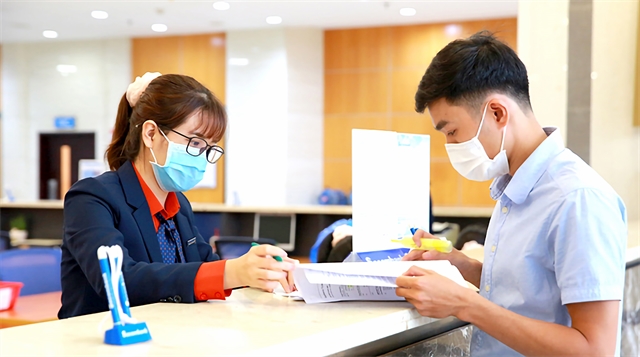 Economy
Economy

The State Bank of Việt Nam is expected to expand room for credit soon due to strong demand for capital in the rest of the year.

|
| A member of staff talking to a customer at Sacombank's office. — Photo sacombank.com |
by Ly Ly Cao
HÀ NỘI — As companies and manufacturers accelerate production after social distancing orders were lifted in most cities and provinces, especially in the south, demand for capital is on the rise, boosting banks’ credit growth in the last months of 2021.
The value of seafood exports bounced back in October after declining sharply for two months, said the Việt Nam Association of Seafood Exporters and Producers (VASEP). Accordingly, the value of seafood exports reached US$918 million in October, up 47 per cent compared to September. By the end of October, the country's seafood exports climbed 2.4 per cent year-on-year to $7.1 billion.
The positive result was mainly thanks to rising orders from key importing markets including the US and European Union (EU). Orders keep coming while production cannot keep up with export demand.
Other sectors like leather and footwear, and wood products also witnessed quick recovery after a long break due to the fourth outbreak of COVID-19.
With the normally busier than usual period at year-end with festivals and holidays, enterprises are speeding up production and expansion to meet strong demand, resulting in higher need for capital.
Phan Đình Tuệ, Deputy General Director of Sacombank, said that after being affected by the pandemic in the third quarters, the bank's credit business has recovered since October.
Many businesses need to borrow capital to serve the recovery of production and business activities, while the bank also provides loan packages with preferential interest rates to accompany customers. Therefore many customers are more interested in credit capital.
Although banks have not lowered lending standards, they focus on supporting businesses under Circular 14/2021/TT-NHNN issued on September 7, amending and supplementing a number of articles of Circular No. 01/2020/TT-NHNN issued on March 13, 2020 on directing credit institutions and foreign bank branches to reschedule debt payments, waive or reduce borrowing interest and fees, and maintain debt groups to support customers affected by the COVID-19 pandemic, Tuệ added.
Each bank also has its own incentive mechanism for customers.
“As long as customers meet the credit conditions, the bank will disburse normally, even if customers who have debt restructured according to Circular 14/2021/TT-NHNN need new capital to serve business, the bank will still approve them," Tuệ said.
Nguyễn Hoàng Minh, Deputy Director of the State Bank of Vietnam (SBV) branch in HCM City, said that after the social distancing measures were loosened, the city recorded many new credit applications.
A recent report by SSI Securities Corporation (SSI) estimated that in October, an additional VNĐ77.7 trillion (US$3.4 billion) of credit was injected into the economy, nearly double that of September. Of which, the trade and service sectors accounted for the highest proportion with about VNĐ34.9 trillion of newly granted loans, followed by industry and construction with VNĐ15.6 trillion.
As of October 29, credit growth was 8.72 per cent compared to the end of last year. "Credit growth is more positive than expected, showing the recovery of the economy after social distancing," said SSI.
However, based on its calculations, SSI said that by the end of the third quarter, most banks have reached their 2021 credit limit. Therefore, the securities firm expected that SBV will soon extend the credit limit for banks with good asset quality and safety indicators.
Cấn Văn Lực, Director of BIDV Training School, said that as the country is trying to boost economic recovery, the state bank should consider increasing the credit limit for a number of banks, regardless of size.
“Of course SBV has to make sure it doesn't rise too much. I think somewhere around 12 – 13 per cent, even 14 per cent is perfectly appropriate,” Lực added.
In its recently released report, KB Securities Vietnam JSC (KBSV) said that the third quarter financial statements showed that the asset quality of commercial banks, although it takes a few more quarters to accurately assess, was not affected strongly by social distancing orders.
“This is the basis for SBV to soon grant more credit room to banks,” KBSV said in the report.
At a meeting with investors held in early November, Nguyễn Hoàng Linh, General Director of Vietnam Maritime Commercial Joint Stock Bank (MSB), said that the bank expects to reach a credit limit of 25 per cent for the whole year, after credit grew nearly 16 per cent for the first nine months, higher than 10.6 per cent at the end of June.
MSB is a bank with good risk management, focusing on disbursement to sustainable development industries, actively participating in activities and policies of the State Bank. Therefore the bank is expected to get credit room extensions, based on the balance and allocation of the management agency, at the end of the year, Linh said.
Many other banks are also waiting for the credit room to be extended to meet businesses' capital needs at the end of the year.
On the interest rate front, experts said that although the interest rate level continued to remain low in the last two months of the year, it is difficult to see further declines, especially when other investment channels such as stocks and gold are attracting cash flow in the market. — VNS




